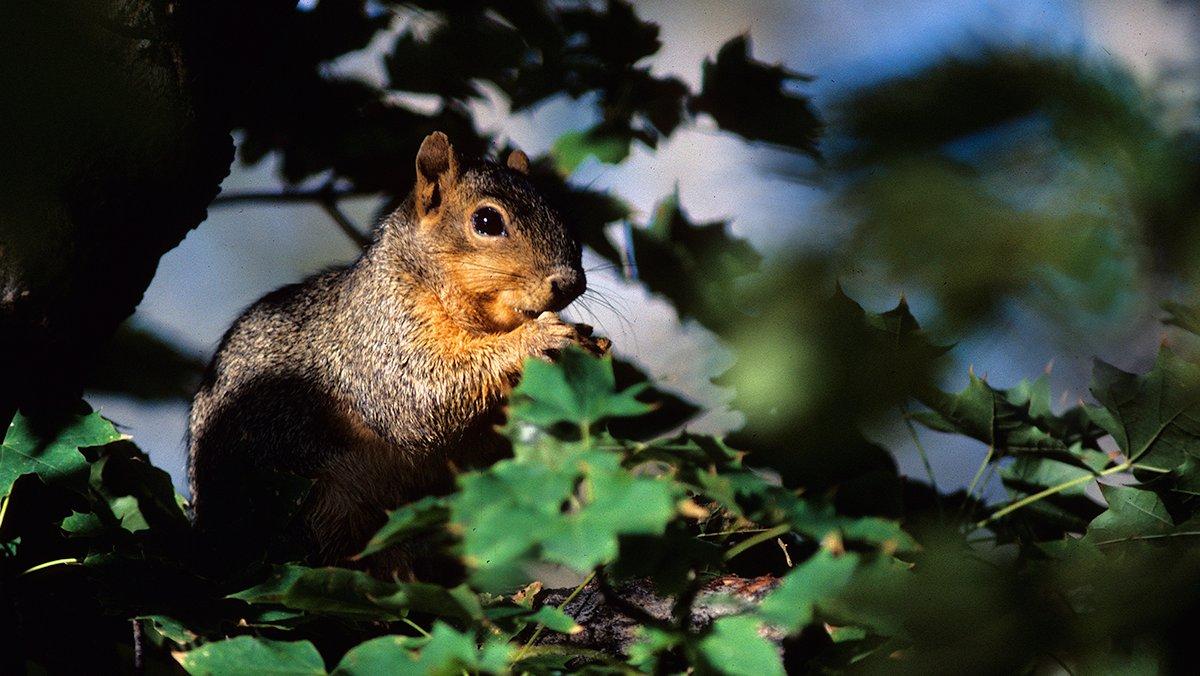Tactics for hunting our largest tree squirrel aren't the same as for more common gray squirrels
Let's go chase after a fox squirrel.
Those were the last words I remember my friend Hunter saying to me before we wandered down the logging road that cut through the top of Brush Mountain. I was cramming my brain with communication law court cases for an exam. He knew exactly how to escape the books.
In a sudden dart down the mountainside, Hunter vanished into the fall foliage. I scuffled through the leaves behind him the best I could in rubber boots to find him encouraging me to hurry. He handed me the .22 Magnum.
It's a fox squirrel, Hunter whispered. The squirrel was frozen high up in an oak tree.
I aimed the gun to the sky. It took me too long to steady my shooting position, and I was certain the squirrel was going to move. But he remained still as a statue, and at the shot, the squirrel fell through the autumn air. Its fur was auburn and delicate, and its tail felt like silk.
Fox Savvy
Fox squirrels are twice the size of gray squirrels, and they can have various colorations. There are a few different subspecies that can be a little different in appearance, but they're all similar in behavior and habits. Southeastern fox squirrels found in big pine forests in more southern regions often have a blacker coloration, but most are reddish-orange.
In my home state of Virginia and most of the southeastern U.S., fox squirrels are most prevalent in the Blue Ridge mountains or in mixed open pine and hardwoods. They love open understory and woodlots more so than deep wilderness areas and large swaths of unbroken forests. They're commonly found on the edges of farmlands near cornfields and open pastures, and though they're good climbers, they frequently forage on the ground.
Marc Puckett, small game project leader for the Virginia Department of Game & Inland Fisheries, says squirrels foraging for longleaf pine cones is a common theory. They have bigger home ranges, bigger homelands, and they like open understory like burned pine, Puckett says.
How to Hunt Them
Fox squirrels are most active during the fall in September, October and November. Wait until the weather cools, and you'll find them in mast trees. Like gray squirrels, fox squirrels will most likely be munching on acorns, hickory nuts and berries. Puckett says that fox squirrels tend to eat fungi, too, because of their tendency to roam the ground frequently. They are also famous for eating walnuts. Ed Lewis, a member of the Central Virginia Squirrel Hunters, says he frequently finds them near walnut trees.
Carefully walk the edges of timber near a field, or through open forest on a calm day. Hunting after a rain is ideal, since moisture on the ground helps you sneak quietly through the leaves. Search the ground ahead for fox squirrels before scanning the treetops. When hunting them in the open forest, listen for falling acorns or hard mast.
You can hear them cutting hickory nuts if you sit quietly. On a quiet day in the woods, you have to scout and look for cuttings and sit still in those areas, and you can hear the shells falling, says Puckett.
Like gray squirrels, fox squirrels call, or bark, to locate one another and when they're alarmed. The sound is a different rhythm from a gray squirrel's, and a little deeper, says Puckett. But if you hear one calling, you can often move closer for a sighting.
I felt fortunate that the squirrel gave me what seemed to be an unusually long opportunity to pull the trigger, but Puckett says that fox squirrels generally do not move as much in the treetops as gray squirrels, preferring instead to sit still when they detect danger.
When squirrel hunting, it's ideal to tree a squirrel on an outer limb with minimal brush for a clean shot. Try to flap a hat around the tree to move the squirrel to an easier shooting location in the tree.
Why Squirrel Hunting Is Good
Hunting fox squirrels is important for conservation because it generates funds to enable the research that helps manage the species. License funds and dollars spent on firearms, ammunition and equipment for squirrel hunting impact the revenue given to state wildlife agencies to continue protecting and managing for wildlife.
Squirrel hunting has a huge economic impact in Virginia because of competition hunts that people travel to, and a lot of money is spent on licenses, dog food, state forest permits, and other elements that are required to hunt squirrels, says Lewis, who frequently participates in competition hunts with his children.
Small game is the best way to introduce youth to hunting, too. It helps them understand the woods and wildlife by practicing using their eyes and ears to learn how animals move before progressing through to big game. All that walking with the constant action of hunting squirrels teaches them gun safety and good marksmanship, too, Lewis says.
Though Lewis' children now hunt all sorts of game in Virginia, he introduced them to squirrels initially. And squirrel hunting remains their favorite.
Learn it, try it, and introduce it. As always, check your state hunting regulations on squirrel seasons. One of my most admirable moments was on that long haul across the mountain as the moon rose over Blacksburg, with a plush trophy tail in the pack to rest with other hunting remnants scattered across my vanity at home, and a squirrel casserole dish to prepare for game day that weekend.
Good Eats: Michael Pendley's Old Fashioned Squirrel and Dumplings on Realtree's Timber 2 Table.
More Realtree small game hunting. Follow us on Facebook.









